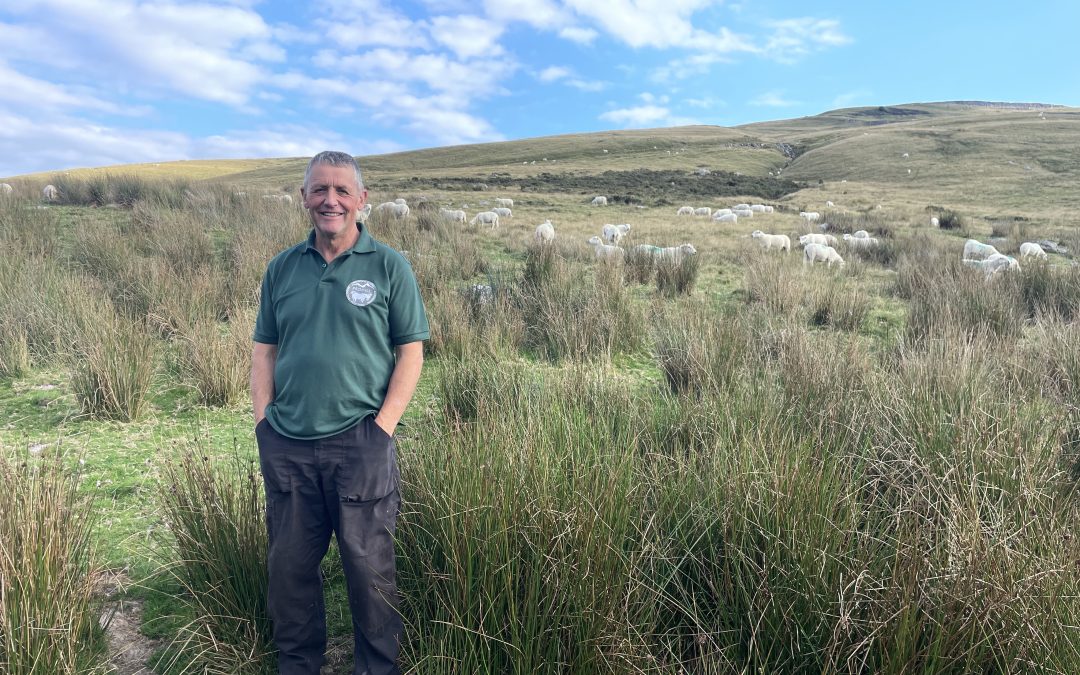Sheep are here to stay to correctly manage the hills, says Colin Evans who has grazing rights for his 350 Welsh Mountain ewes on the Black Mountains. “Sheep are vital for managing the grazing, maintaining the diversity and carbon capture, as well as minimising the fire load.
“However, breeding a hardy ewe that not only survives but thrives without any inputs on the rhosfa
Is essential; we initially select for teeth and fleece together with hardiness, and in the last four years we’ve joined HCC’s Hill Ram Scheme to commence performance recording, further improve the flock’s efficiency and develop an opportunity to add value by selling rams through the Prohill marketing group.
“It’s a case of resilience to the fore and we have finally reached the point at which we are breeding a Welsh Mountain ewe that thrives in our system,” explains Colin who farms with his wife, Rhian at Nant Moch, Llangadog. “The flock grazes on the Black Mountains at between 900ft and 1,600ft for nine months of the year and is currently averaging 125% scan and 115% reared, we lamb as yearlings and ewes are averaging seven crops.”
The Evans arrived to Nant Moch 25 years ago. “We spent the first decade attempting to breed a bigger stronger more powerful ewe until we realised that these lanky, narrow 65kg individuals were hungry ewes and cost far too much to keep, particularly on winter tack; we simply weren’t making any money from the sheep enterprise.
“We changed direction and selection criteria, we invested in hardier more compact rams which proved difficult to find, and today the flock is averaging 50kg mature weight and producing a 40kg lamb. These ewes are deep-bodied suited to graze our rhosfa and with capacity to turn roughage into quality protein – that’s what it’s all about.
“As far as selection criteria is concerned, I continue to prioritise teeth and fleece – essential when a ewe is out on the mountain for most of her life, and that includes all the twin and triplet bearing ewes otherwise that would defeat the objective of breeding a hardy ewe. The flock comes down only for shearing, tupping and lambing outdoors.”
Next, Colin says he selects for hardiness and depth of body before checking out EBVs for muscle depth and backfat from the last crop of lambs. Performance recording has introduced increased efficiency, and the opportunity to use EBVs is proving to be the final piece of the jigsaw.
“We joined HCC’s Hill Ram Scheme to learn more about the flock’s backfat and muscle depth, simply because you can’t see below the skin. Performance recording is another tool in the box and provides information I can’t access anywhere else to help in decision-making.
“We select from within the top 25% for muscle depth EBV retaining ewe lambs for replacement purposes and ram lambs for sale via the Prohill marketing group the following year. We’re not looking for high-flying fast-growing lambs – the hill cannot sustain high growth rates consequently, muscle depth is a critical EBV together with good fat, because. Those within the top 10% for growth don’t suit our system, however, we are happy to select breeding rams and lambs with above-average EBVs for maternal and other traits.
“Backfat is an important EBV since when the ewe comes off the mountain for tupping we give her five weeks to put on flesh before returning to overwinter from 1 December to end of March without any concentrate or supplementary forage. Any ewes unable to survive are culled, there’s no second chance. However, we supplement with 20 blocks strategically positioned so as to attract them to sheltered areas and winter feed costs amounted to an acceptable 97p per ewe.”
Lambs which aren’t retained for breeding purposes at Nant Moch are finished to an average 39kg in a simple a least-cost system.
Colin adds: “Our objective is for a Welsh Mountain flock within the scheme’s top 25% whilst maintaining its ability to thrive. We believe we’re getting closer to achieving that goal each year.”
